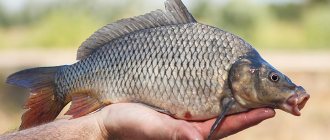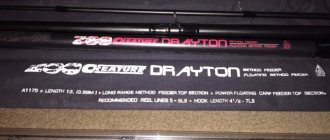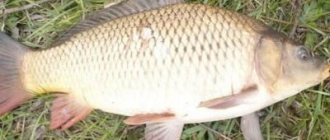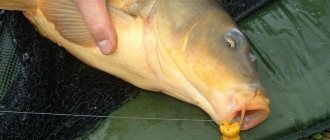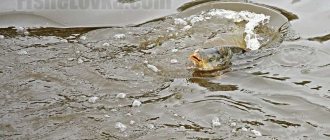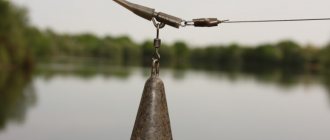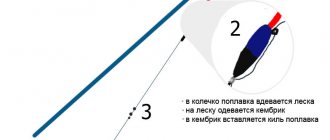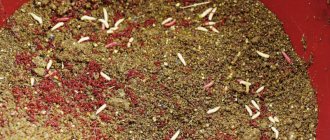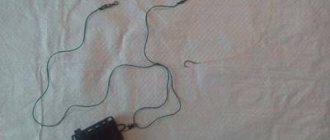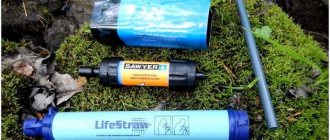In this article (for beginning carp anglers) we will talk about such an indispensable element in a carp angler’s equipment as a fishing marker.
Most likely, many new anglers have faced this (often very nervous) question: where and at what distance should you catch carp? And in general, what is under the surface of the water surface, in the area we have chosen? Because, having arrived at a reservoir (especially an unfamiliar one), we do not know either the depth or the features of the bottom at a promising fishing point. But excellent knowledge of the fishing sector is the most important guarantee of successful carp fishing. Especially if it is also a hunt for a trophy specimen. This is where our entire strategy for the future session is based.
This mysterious underwater world...
Why do we need a marker for carp fishing?
Carps are incredibly smart and cunning fish with associative memory. They like to stay in certain places, where sometimes even the best food cannot lure them out. But they all have a small weakness, which helps to catch them - natural curiosity. Carps, due to the physiological characteristics of the digestive system (they do not have a stomach), must constantly move around the reservoir in search of food.
Therefore, our primary task is to discover its feeding areas and the “paths” along which it moves to the “dining areas”. In order to achieve success, it is necessary to study in detail the place of future fishing, and accurately scout all its “tables” (i.e., feeding places). Where, then you will need to throw bait, and you can fish longer. To achieve this goal, it is important to find literally EVERYTHING at the bottom that, at least a little, stands out from the general background. Such zones are promising in terms of carp fishing. It can be:
- areas of hard bottom against a background of silt or detritus;
- depth changes (even minor)
- boundaries of aquatic vegetation;
- stuck areas of a lake or pond;
- as well as areas of the bottom covered with colonies of shells, etc.
These are the places you need to pay attention to – first of all! Of course, you can study the bottom of a reservoir from a boat, using classic surveys that sailors used in ancient times (mainly to measure the depth in front of the keel of a ship). Or a more advanced device - an echo sounder. But, if due to circumstances it is not possible to use the float. funds, but an echo sounder is not yet affordable; or at sporting competitions, where the rules strictly prohibit the use of echo sounders and boats, what to do in such force majeure cases? Here a tackle with a special sinker and a float marker will help you and me.
We study the reservoir. Part 1. What is a marker? How to properly rig a marker rod?
Section: Articles about fishing
Hello, dear lovers of fishing and carp fishing in particular. Today we will talk about one of the most indispensable things in the equipment of a modern carp angler, like a marker.
In his fishing practice, perhaps every fisherman asked himself an insoluble question: where, and most importantly, at what distance to fish? And what is the bottom topography under the surface of the water at your favorite fishing spot? After all, upon arrival at a body of water (especially for the first time), the fisherman does not know either its depth or the composition and topography of the bottom at his chosen (or chosen by lot at fishing competitions) workplace. But good, I would say, thorough knowledge of the reservoir is the key to successful fishing, and in particular, if this is a “hunt” for large specimens of any fish, but, in my opinion, especially carp.
This fish very often stays in certain places, from where it is very often impossible to lure it out with the best food! Therefore, in order to successfully fish, you need to thoroughly research the place of the upcoming fishing, and correctly determine the working “tables” where you will feed and catch. To do this, you need to find at the bottom everything that is at least somewhat different from the general one. Such zones are promising places. This could be: a piece of hard bottom against a background of silt; depth difference (even not very significant); boundary of aquatic vegetation; a patch of snagged bottom; a section of the bottom covered with colonies of shells, and similar features and differences.
It is places like this that you should pay special attention to. Naturally, you can study the bottom of a reservoir from a boat using a sinker-lot, which sailors used in the old days (yes, often now) and also for measuring depths, or a more modern device - an echo sounder. Well, if for a number of reasons it is not possible to use a boat, and an echo sounder is still more of a toy, unaffordable for most of our fishermen, or at sporting competitions where the rules prohibit the use of boats and echo sounders, what to do in such cases? This is where a tackle with a special weight and a marker float will come in handy!
What is this float? The marker is a large and brightly colored float that is clearly visible even at a distance of over a hundred meters. But to work with a marker you need some equipment.
Marker rod equipment
To work with the marker we will need: a carp rod 12 or 13 feet long (360 or 390 cm), with a test of 2.75 lbs for weights of about 85 g, or 3 lbs for a load weighing about 100 g, fast action. The rod blank is marked in the form of a kind of ruler with marks of 5-10 cm, and so on from 0 to 50 cm. Using these marks you will measure the distance until the float rises when measuring depths.
The rod is equipped with a spinning reel with a long and shallow spool (long cast). It would be useful to have a baitrunner, since when measuring depths and releasing the fishing line, you won’t have to constantly release and tighten the friction brake, but only work with the flag to turn it on and off. We wind braided fishing line with a diameter of 0.18-0.22 mm onto the reel spool.
The last 16-18 meters are a shock leader (depending on the expected depth in the reservoir) made of monofilament fishing line with a diameter of 0.40-0.45 mm (or we use a standard conical “leader”, which is commercially available).
And this is why a monofilament leader is needed: a braided cord practically does not stretch and, due to this, more clearly conveys the movement of the load along the bottom, but it is soft, and therefore during casting it can twist around its axis and overwhelm the float, which simply cannot float up, The monofilament shock leader is much more rigid and does not get tangled when casting. We will also need a marker float, a marker sinker and accessories.
Installation of marker equipment
Having assembled the rod and reel in the “fighting” position, we pass the free end of our shock leader into the eye of the sinker, put on a stop bead to protect the knot on the float and tie our float.
So, our tackle is ready for work. And here I want to remind you that the marker equipment should be as harmonious as any carp equipment, because floats and sinkers come in different designs. Markers vary in carrying capacity: light (they have a tall, elongated body and have a longer flight range) and heavy (they have a thicker body and fly worse, but due to their greater displacement they float faster). Therefore, when selecting a sinker and float, it is necessary to take into account their weight and carrying capacity.
Marker float
What is it and most importantly - how should it be used? A “marker” is a fairly large / brightly colored float that is clearly visible even at a distance of more than 100 meters. Marker floats come in different shapes and displacements. The most popular models have a thin/long shape, somewhat reminiscent of a cigar. It must have a brightly colored top, on which stabilizers are located that do not allow the float marker to lose its trajectory during flight. Although, despite the fact that these products “fly” well, they still float up poorly (due to their small displacement). Therefore, strictly for certain situations, modern manufacturers also produce short/thick floats. Of course, they don’t fly quite perfectly, but they float up very well (thanks to their large displacement).
However, to work with a marker float you also need to have a special fishing rod. Why do we need it?
Making tackle
If we have all the components of the tackle with a marker float, we can start putting everything together.
We equip the rod:
- The reel is attached to the rod, then the fishing line is wound.
- The line is threaded through all the rings of the rod
Now we assemble the equipment itself with a marker float:
- We thread a sinker with a large eye into the fishing line. The eyelet should be free of burrs, so as not to injure the fishing line. The sinker should move easily and freely along the line.
- We attach a stopper 20 cm from the end of the fishing line. It is easiest to use a rubber or plastic bead, and it must be attached very firmly, it should not move along the fishing line. If you don’t have a rubber stopper at hand, as a last resort you can use a lead pellet, but it is much worse than a rubber bead, since it does not absorb the impact of the sinker well, and also greatly deforms the fishing line.
- A marker float is attached to the end of the fishing line using any reliable knot. Now the tackle is ready.
Design with a removed sinker and a free ring, which guarantees unhindered and free movement of the line through the ring
Marker rod
Many fishermen (especially beginners or NOT fans of carp fishing) make a big mistake: when buying a new rod for carp fishing, they put a marker (float) on the old one. Then they try to work with them and for a long time cannot understand: why is it not working out for them? Yes, everything is actually very simple! Firstly, other carp rods (i.e. working or spod rods) are made using completely different technologies than marker ones. Accordingly, the structure of these fishing rods was developed for completely different types of tasks. For example, the main purpose of a working carp rod is to provide us with the opportunity for long-distance, accurate/power casting, as well as dampening (absorbing) jerks during the moments of retrieving our catches.
To work with a marker rod, you don’t need such extremes! Because here it is extremely important to have a high level of sensitivity when transmitting signals from the sinker to the tip of the rod, and then to our hand. Therefore, in the manufacture of “markers” a completely different technology is used. As a rule, they have a hard action, but a very soft tip that reacts to literally everything that happens to the sinker on the bottom. Marker rods also have small inserts in the rings (on working forms they are needed to reduce friction of the fishing line on the rings), and a cross-sectional shape close to a square - for more effective friction of the fishing line on the rings. Which, in turn, increases the sensitivity of the entire equipment and contributes to a clearer transmission of signals to the rod blank and, accordingly, to your palm.
It is also important that marker rods have special markings on the form, located just above the reel/holder for the most accurate depth measurement.
Manufacturers produce marker rods (popularly known as “markers”) in 3 main directions:
- lightweight (allowing you to work with weights weighing from 85 to 90 grams);
- medium (designed to work with loads from 110 to 120 grams);
- and heavy (weighing up to 140 grams, which affects casting distances).
What types of fishing rods are there?
Special gear and equipment are produced for carp fishing. The carp angler's list is impressive: from fishing rods to carp mats. The rod has a special design that allows it to cope with the indicated loads. Different fishing conditions require the use of different rod action, type and length. There are two groups of these products:
| View | Description |
| Basic (working) | Designed for fishing, casting and retrieving. |
| Auxiliary (spod and marker) | Used to study the characteristics of the fishing site and feeding the fish. |
In turn, workers are divided into two types:
- Telescopic. Pull-out type product. Sections of varying thickness, tapering from the handle to the apex. When added, one section is obtained. Not used as often as plug-in ones. The main advantage is mobility and compactness.
- Plug-in. The design is sectional and can be disassembled into separate parts, which during assembly are fastened together using bushings. Number of sections: five, three and two. They are particularly durable.
The choice of the optimal zone is of no small importance for carp fishing. This involves a thorough study of the bottom topography: depth and what type it is (silt, sand, driftwood, gravel, and so on). If you determine the direction in which the fish is moving, you can increase the chances of achieving the desired result. Marker equipment will help with this.
For this type of fishing, an excellent option is a flat bottom with hard clay areas in the middle of marshy silt or shell rock.
The main structural elements of the equipment are considered to be:
Reel
Almost all marker rods are equipped with large reels with a baitrunner system. Their use is completely justified, since they make it possible to quickly release or tighten the main clutch, as well as gradually release the fishing line from the reel if there is a need to frequently measure the depth. These steps will help you determine the bottom map with great accuracy.
Spools are available for the following types of reels:
- with a front vertical side (the inner edge has no slope);
- with reverse cone.
There are clips to fix the fishing distance. A marker rod has two or one of them. If you reel out the marker overnight, then the fishing line is placed in this clip so that in the morning, when determining casting guidelines, the float hits the desired point, and then install it in the place of the previous fishing.
fishing line
Tackle of this type involves the use of braid (from 0.15 to 0.25 mm). It is worth keeping in mind that the thickness of the fishing line directly depends on the casting distance. Thin “braids” have certain disadvantages:
- short service life;
- frequent overlaps occur;
- entanglement cannot be avoided.
The leader shock, which comes complete with a rod and braid, is made of a cone shape from monofilament. The device is used for long casts, without weighing down the marker. Its thin side is attached to the fishing line, and its thick side is attached directly to the float. The product differs in the size of the breaking load on the thick end of the monofilament. A 3.5 ounce weight corresponds to a leader with a load of 35 Lb; a 4 to 5 ounce sinker corresponds to a leader with a load of 45 Lb.
Float
Basic requirements for this element:
- should float well;
- the presence of excellent aerodynamic properties (important for casting);
- brightness;
- visibility.
The manufacturing process uses high-strength lightweight plastic. The element is hollow inside. There are several options where you can buy a similar attribute: visit any fishing market or order online in an online store. To do this, you do not need to analyze the popularity of models. It is very easy to determine which one is better to buy. The main selection criteria boil down to the following: good floatability, bright plumage, low cost.
Sinker
There are options with spikes, which, in contact with the unevenness of the bottom, determine its relief by transmitting vibrations to the tip of the fishing rod. Several types of marker sinkers are produced, including for fishing on slopes and currents, where the best option is flat massive sinkers (up to 5 ounces). On sale you can find specimens with a wire extension, which makes it possible to raise the fishing line above the bottom.
Marker equipment
The marker rod is equipped with a spinning reel (with a large line capacity) filled with braided cord. With the exception of the last 10-15 meters of mono line (used as a shock leader). Why is the reel spool filled with braided cord? Unlike monofilament fishing line, braided cord does not stretch, and therefore better transmits the vibrations created by the sinker when it is “dragged” along the bottom.
But there is one problem: since the wicker material is very soft, when casting it can simply “twist” and then prevent the float from floating up. That is, you will find a promising fishing point, but the float will not float up. Thus, you will not be able to confirm for yourself its “prospects,” which you will agree is very annoying. To solve this problem, use a shock leader with a mono line (large diameter) or ready-made cone shock leaders. They never get tangled while casting!
We will also need special weights for marker equipment, on the surface of which there are large spikes. Although, any flat sinker or “flu” will do, the main thing is that they all have a swivel in their design.
When you bring your rod and reel into “combat readiness”, pass the free end of the shock leader into the eye of the sinker (only we MUST select it according to the TEST of the rod). Then put on a stop bead (to securely secure the knot on the float) and tie the float. That's all the wisdom! Now your marker equipment is assembled and ready to go!
The right equipment for taking measurements
Rod
The first thing that is important to choose is a fishing rod. Most of the products are made of carbon fiber, each layer is impregnated with a special substance. The cost of the structure depends on the quality of the main material and binder resin. The last component can be impregnated in several ways, but the preferred ones are vacuum or autoclave.
Thanks to the lightness of carbon fiber, all signals are transmitted more accurately, in contrast to the working structure, which is too heavy to measure the bottom. However, the light weight of the structure does not in any way affect the strength indicators; they are still at a high level. To increase the plane of contact of the fishing line, there is an elastic tip at the end of the structure. It ensures good transmission of vibration to the hand.
The standard dimensions of such a rod are 3.6 meters, with a test weight of 100 g. These parameters are enough to throw a weight over a distance of 100 m. When a person needs to cast further, it is best to use longer designs with a test weight of 180 g or more. In this case The maximum throwing range will be 150 meters.
There are special marks on the rod body. They are located at a distance of 10-15 cm from the line layer. There can be any number of such tags, it all depends on the preferences of the fisherman. It is possible to record or mark readings in various ways: starting with ordinary white electrical tape and ending with proofreaders.
Reel Features
The coil must be selected based on several criteria. It is important to take them into account because the cargo is delivered over a long distance, and is quickly pulled up, thereby marking the depth of the bottom. The main parameters of a reel for a marker rod are:
- Small mass. First of all, this indicator is focused on convenience, since studies can be carried out for two or more hours;
- The spire must have a large diameter;
- The optimal solution is to buy a reel with a quick clutch release system, this will increase comfort during operation;
- Winding should be carried out quickly but evenly;
- It is advisable that the fishing line does not get under the spool, otherwise unraveling will take a lot of time.
Finding such a reel will not be difficult. Such models are produced by all top manufacturers. The main thing is convenience and a system for quickly releasing the clutch. The brand does not play a special role here.
Correct selection of fishing line
For a marker rod, two types of this element are often purchased: monofilament line or thread. If a person purchases the first option, then it is important to understand that it has some disadvantages, for example, an error in determining the relief. This problem occurs due to the fact that the product is stretched during strong currents and gusts of wind. Therefore, professionals recommend buying special threads that can save the user from such disadvantages, while it will not wrap around the pin.
The main difference between a float
The float can be found for both 10 rubles and 1,000 rubles. The difference between these varieties is large. It is better to purchase a special model that is designed for use in a marker rod. Because it will float up quickly, and this is an important parameter when exploring the bottom.
Another important point is carrying capacity. It is desirable that this parameter exceed the weight of the special sinker. An excellent option is when the difference is up to 30%. For example, if the maximum load capacity of the float is 25 grams, then it is best to use 35 g weights. If this rule is not followed, the sinker will rise from the bottom, which will affect the accuracy of the readings.
Sinker selection
Most professional fishermen use studded weights. The main distinguishing feature of this option is the identification of shells, blades of grass and stones at the bottom of the reservoir. For a marker rod, this indicator is most in demand. A smooth sinker can be used, but the user will not be able to obtain detailed information, which will affect the quality of the bite. When using weights with wings, you should remember that the element is equipped with a bend, the length of which is important to constantly take into account and add up with other calculations.
The minimum weight of weights is 30 grams, the maximum value is 150 and above. If a person only needs to understand the edge at the bottom, it is enough to use models weighing up to 50 g. The second thing that beginners should take into account is that the maximum casting distance depends on the mass of this element. It is advisable to buy a sinker with a light weight if you are exploring the bottom at a distance of 150 meters.
There is a third model of weights - round. It is used in cases where a person needs to know only the depth of the bottom. This product is not capable of more.
How to use a marker to measure depth?
Which depth measurement procedure will be the simplest and most understandable for a beginner? Let's give simple examples. So, we send our sinker to the farthest distance possible. And we wait until it falls to the bottom. Next, we control the tension of the fishing line when the float rests against the eye of the sinker. Then, having released the clutch, or turned off the baitrunner, we begin to release the fishing line (according to the marks on the rod. Until your marker float appears on the surface. The length of the released cord (we are guided by the marks and the number of releases) is the depth in this area reservoir
Then we rewind the cord again, having first turned on the baitrunner or tightened the clutch until the float rests against the sinker. We place the rod horizontally in the direction of the descent of our fishing line, and its tip should look exactly at the casting point. And smoothly (without haste) we move the marker rod to the side. Moving its tip approximately 80-85 degrees, stretch the sinker along the bottom in your direction for 3-3.5 meters. Next, we repeat this depth measurement operation several times.
Thus, you can quickly and, most importantly, accurately measure all the depths in the area you like. Depth measurements must be carried out according to a “fan” pattern, relying on any landmarks located on the opposite bank (of course, if there is such a possibility). Experienced carp anglers (while working with a marker) make notes on a piece of notebook, where a plan of the fishing area is drawn in advance (with all the landmarks, fishing distances and bottom characteristics). As a result, they receive the most detailed picture of their area (sort of like a map), and then make a decision: where exactly and what exactly they will use to catch their trophies.
How to determine the depth in a given area of a reservoir using markers
This requires intermittent movement of the load along the bottom. The rate of all movements is controlled by the number of spool revolutions. The shorter the distance when moving, the more detailed the picture of the bottom relief can be understood. For example, a reel reels out 20 cm of line per revolution. Accordingly, when tightened with ten turns, the marker sinker will approach the shore 2 meters.
Before using a marker float, you need to prepare your rod in order to accurately take measurements. For this purpose, at a certain distance from the reel seat, a convenient distance for counting is marked (usually 50 cm) and a mark is applied to the fishing rod with a felt-tip pen.
The marker float moves in specified ranges
You need to move the weight while studying the bottom until the monofilament is fully tensioned. Then the line is gradually released from the spool until a float appears on the surface. By counting the number of line drops, and also knowing the distance to the weight, you can very easily find out the height of the float in this area.
But the most important thing in this case is not the study of the depth, but the features of changes in the bottom topography, so you can find out in what place the feeding table, hole, edge, etc. is located.
In order to clearly hit this point during casting, the line on the spool is clipped. If the coastline allows, then the line of the marker and the working feeder are reeled out to the coast and clipped at the same distance
Recommendation: On an overgrown bank, pegs are used for this, which are driven in at a distance of 1 m from each other. Afterwards, the scaffolding from the marker and the working stick is simultaneously wound onto them, and then everything is clipped at the same distance.
Such measurements are carried out several times at different angles relative to the shore.
This way you can get a real picture of the fishing spot, since when fishing on the feeder, sometimes up to four fishing rods are installed at once.
For a professional fisherman, determining the bottom topography takes about one hour. However, this is not wasted time for fishing, since these manipulations make it possible to accurately identify the feeding areas of carp and other fish. Next, you need to study the behavior of the proposed fish, “favorite” baits, find out the impact of weather conditions and many other things that affect fishing performance. This comes with experience.
Studying the bottom topography using a marker
Using the method described above, you can measure depths at fairly large distances from the shore. However, you and I are interested not only in this, but also in the condition and structure of the bottom (relief) in the selected area of the reservoir. So, this can be determined by how our sinker moves along the bottom.
1) Muddy bottom
The most common example is the presence of silt at the bottom - this is where the sinker will get stuck. And how “strongly” it sticks indicates not only the thickness of the silt layer, but also its consistency. When dragging a marker sinker stuck in silt, the following happens: at first, it goes hard and very slowly, and then it becomes easier and faster. But if you pause, the sinker will get stuck again, and to move it from its place, you will again need to apply force.
2) Underwater vegetation
In the presence of underwater vegetation, the marker weight will initially move normally, but then become thoroughly stuck and, accordingly, stop. In the process of dragging the sinker through aquatic plants, you can even hear the stems tearing under the water.
3) Is the bottom sandy or gravel?
On a sandy bottom, your sinker will move easily and evenly, and the rod tip will always be slightly curved. On the bottom covered with gravel or colonies of shells, the load will also move normally, but with slight jerks, and the tip of the rod will tremble slightly. It is worth noting that experienced carp fishermen can even by ear detect the dragging of a marker sinker through algae, gravel or shells.
All movements of the load are controlled by the tip of the fishing rod, and by the way it “gives” to our hand.
4) The most trump spots for carp fishing
And finally, the most important question: how to learn to identify areas with more/less hard soil in large silted areas of the bottom? Here it is important to “calculate” the moment when the sinker stuck in the silt is released, and the tip of the rod straightens and begins to tremble slightly. This is a sign that a very promising carp fishing spot has been found. Measure the depth in this place, visually remember the landmarks and range. And after that, make several fan-shaped casts to the left and right to determine the size of this area. After all these procedures, place a stationary marker there as a guide for casting gear and bait. Well, then start carp fishing.
We study the reservoir. Part 1. What is a Marker? How to properly rig a marker rod?
July 21, 2021 Avid fisherman Articles about fishing 135
Hello, dear lovers of fishing and carp fishing in particular. Today we will talk about one of the most indispensable things in the equipment of a modern carp angler, like a marker.
In his fishing practice, perhaps every fisherman asked himself an insoluble question: where, and most importantly, at what distance to fish? And what is the bottom topography under the surface of the water at your favorite fishing spot? After all, upon arrival at a body of water (especially for the first time), the fisherman does not know either its depth or the composition and topography of the bottom at his chosen (or chosen by lot at fishing competitions) workplace. But good, I would say, thorough knowledge of the reservoir is the key to successful fishing, and in particular, if this is a “hunt” for large specimens of any fish, but, in my opinion, especially carp.
This fish very often stays in certain places, from where it is very often impossible to lure it out with the best food! Therefore, in order to successfully fish, you need to thoroughly research the place of the upcoming fishing, and correctly determine the working “tables” where you will feed and catch. To do this, you need to find at the bottom everything that is at least somewhat different from the general one. Such zones are promising places. This could be: a piece of hard bottom against a background of silt; depth difference (even not very significant); boundary of aquatic vegetation; a patch of snagged bottom; a section of the bottom covered with colonies of shells, and similar features and differences.
It is places like this that you should pay special attention to. Naturally, you can study the bottom of a reservoir from a boat using a sinker-lot, which sailors used in the old days (yes, often now) and also for measuring depths, or a more modern device - an echo sounder. Well, if for a number of reasons it is not possible to use a boat, and an echo sounder is still more of a toy, unaffordable for most of our fishermen, or at sporting competitions where the rules prohibit the use of boats and echo sounders, what to do in such cases? This is where a tackle with a special weight and a marker float will come in handy!
What is this float? The marker is a large and brightly colored float that is clearly visible even at a distance of over a hundred meters. But to work with a marker you need some equipment.
Marker rod equipment
To work with the marker we will need: a carp rod 12 or 13 feet long (360 or 390 cm), with a test of 2.75 lbs for weights of about 85 g, or 3 lbs for a load weighing about 100 g, fast action. The rod blank is marked in the form of a kind of ruler with marks of 5-10 cm, and so on from 0 to 50 cm. Using these marks you will measure the distance until the float rises when measuring depths.
The rod is equipped with a spinning reel with a long and shallow spool (long cast). It would be useful to have a baitrunner, since when measuring depths and releasing the fishing line, you won’t have to constantly release and tighten the friction brake, but only work with the flag to turn it on and off. We wind braided fishing line with a diameter of 0.18-0.22 mm onto the reel spool.
The last 16-18 meters are a shock leader (depending on the expected depth in the reservoir) made of monofilament fishing line with a diameter of 0.40-0.45 mm (or we use a standard conical “leader”, which is commercially available).
And this is why a monofilament leader is needed: a braided cord practically does not stretch and, due to this, more clearly conveys the movement of the load along the bottom, but it is soft, and therefore during casting it can twist around its axis and overwhelm the float, which simply cannot float up, The monofilament shock leader is much more rigid and does not get tangled when casting. We will also need a marker float, a marker sinker and accessories.
Installation of marker equipment
Having assembled the rod and reel in the “fighting” position, we pass the free end of our shock leader into the eye of the sinker, put on a stop bead to protect the knot on the float and tie our float.
So, our tackle is ready for work. And here I want to remind you that the marker equipment should be as harmonious as any carp equipment, because floats and sinkers come in different designs. Markers vary in carrying capacity: light (they have a tall, elongated body and have a longer flight range) and heavy (they have a thicker body and fly worse, but due to their greater displacement they float faster). Therefore, when selecting a sinker and float, it is necessary to take into account their weight and carrying capacity.
To be continued…
Thank you all for your attention! No tail, no scales, fishermen!
on social networks: Catching a predator within the city. Interesting fishing Last week there was only one free day off, it was not possible to go somewhere far away, so I decided to take a friend and go to my favorite river within the city. On Friday I called my friend, he didn’t think for a long time, so we’re going. We meet at the place at 3:45 and slowly get ready.
Source: https://fishmanual.ru/statyi/1903-izuchaem-vodoem-chast-1-chto-takoe-marker-kak-pravilno-osnastit-markernoe-udilishche.html
Let's summarize
Despite its apparent simplicity, working with a marker still requires certain skills and constant training for the purpose of self-improvement. And since this method is quite noisy, it is better to practice not while fishing for carp, so as not to scare away all the fish in the area and not interfere with the fishing of other carp anglers. Therefore, in order to hone the skills of using marker gear, as well as develop a “sense of the bottom”, it is recommended for beginners to study strictly (!) in shallow water. Where you can relatively easily check the sensations transmitted by the sinker and line to your hand. Here, in principle, are all the initial recommendations for mastering the use of a marker. We wish you successful training!
Related materials:
- How can a beginner choose a carp rod (working, marker and spod)?
- Bottom exploration with a marker (by carp fishing legend Ian Jameson)
Publication author
offline 7 months
Casting technique
Sadness! But this happens too
Accurate determination of the future fishing location is very important for a fisherman, especially for a carp angler. Therefore, for effective fishing, so as not to rely on chance, it is better not to spare money and buy a marker rod along with a spod in a specialized online carp fishing store.
Good tackle, together with the knowledge, dexterity and quick reaction of the fisherman, are the key to successful fishing. At the end of the article, I recommend watching a Video review of the Marker Rod with an authoritative Russian carp angler, leading expert of the Carp Time company, Alexander N. And I wish you, as always, Happy Fishing!
0
Author of the publication
offline 7 years

